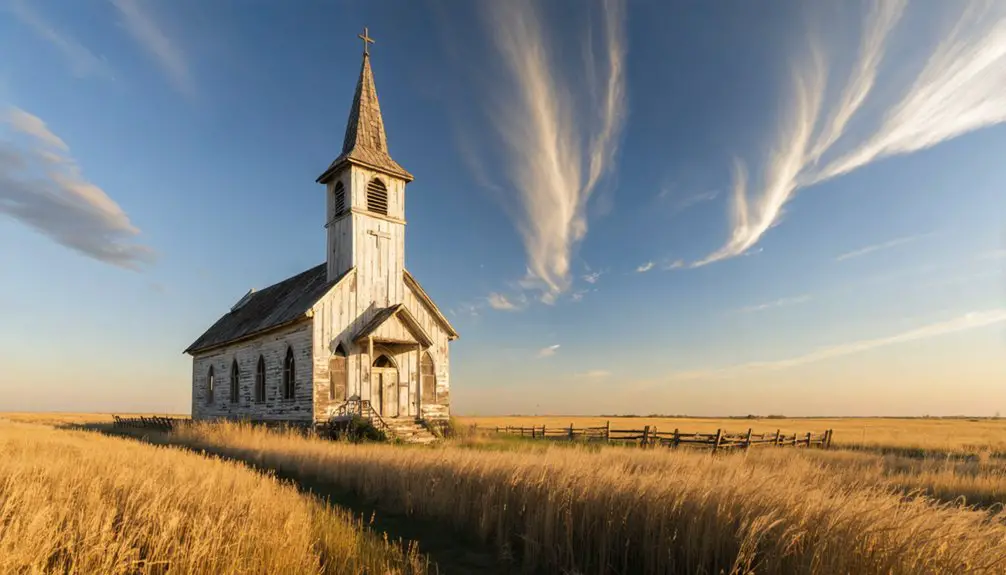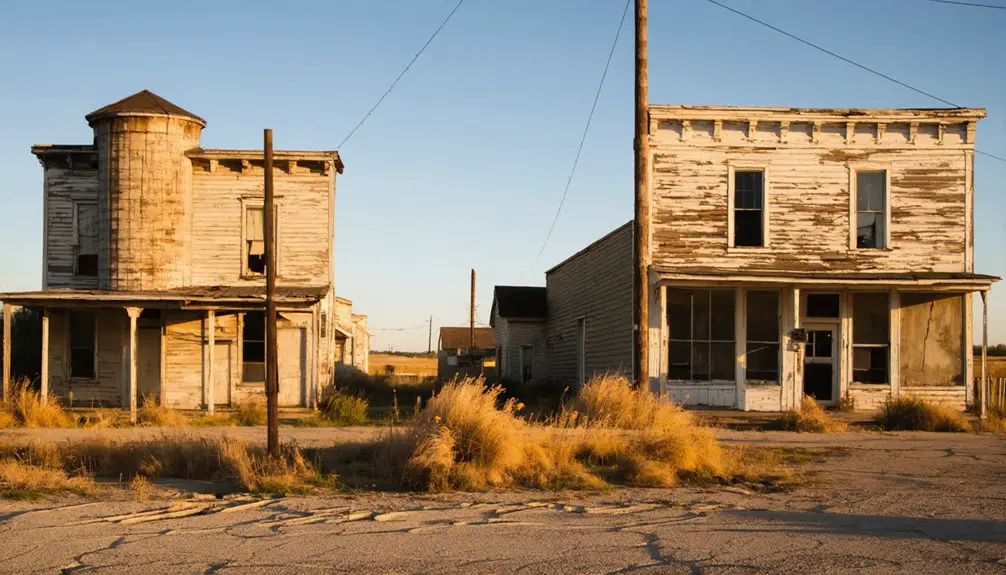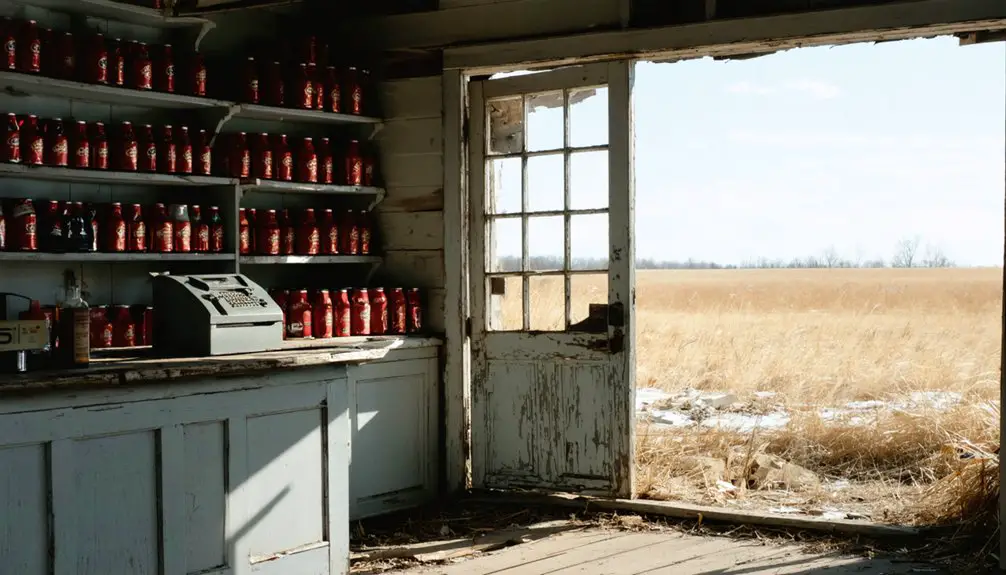You’ll find Canada, Kansas nestled in Marion County, where this former railroad boomtown once bustled with 600 residents in the early 1900s. The town sprang to life in 1883 when the Chicago and Rock Island line arrived, quickly growing to include banks, hotels, churches, and stores. Today, weathered storefronts, an old church, and a well-maintained cemetery are all that remain of this prairie settlement. The silent streets and empty buildings tell a deeper story of Kansas’s railroad era.
Key Takeaways
- Canada, Kansas began as a thriving railroad town in 1883, reaching a peak population of over 600 residents during its prime years.
- The town featured hotels, diners, general stores, multiple churches, and essential services centered around railroad transportation.
- Agricultural consolidation and declining farming opportunities led to population loss as younger generations moved to urban areas.
- Today, Canada stands largely abandoned with empty storefronts, a neglected church, and deteriorating residences marking its former existence.
- The cemetery remains the best-preserved site, documenting the town’s history through grave markers of its former inhabitants.
The Canadian Settler’s Vision
As post-Civil War America expanded westward, French Canadian settlers began arriving in Meridian Township, McPherson County, Kansas during August and September 1871.
In late summer 1871, French Canadian pioneers ventured west to establish new lives in McPherson County’s Meridian Township, Kansas.
You’ll find their vision centered on building tight-knit farming communities while maintaining their cultural heritage. They purchased land from the Atchison, Topeka and Santa Fe Railroad, quickly establishing essential community hubs including a post office, church, school, and cemetery.
These pioneers focused on cultural preservation through French schooling and religious institutions, while pursuing agricultural innovation to transform the Kansas prairie into productive farmland. The region’s semi-arid steppe climate in western Kansas presented unique challenges for the settlers’ agricultural endeavors. The settlers adopted techniques similar to the Mennonites who had transformed swamplands into fertile agricultural regions in Europe.
Like the successful Mennonite settlers, they aimed to create prosperous family farms using railroad land grants. Their commitment to both tradition and progress shaped a distinct community, contributing to Kansas’s diverse ethnic landscape while establishing sustainable agricultural practices suited to the region’s climate.
Railroad Roots and Early Growth
You’ll find Canada’s earliest roots firmly established with the arrival of railroad tracks in the late 19th century, following the broader pattern of Kansas railroad town development seen throughout Franklin County.
When the Kansas City Suburban Belt Railway began operations in 1890, it further connected the region’s small communities.
The railroad’s presence quickly attracted settlers and spurred the establishment of essential services, including a post office and commercial buildings along the tracks.
As rail operations expanded in the early 1900s, Canada emerged as a small but crucial transportation hub, with its strategic location along active rail lines supporting both local commerce and regional connectivity. Like many towns after the Santa Fe Railroad gained control in 1880, Canada benefited from improved rail infrastructure and increased trade opportunities.
Railroad Construction Timeline
The early railroad expansion across Kansas began in earnest during the 1850s, with the Pacific Railroad breaking ground west of the Mississippi in St. Louis.
You’ll find that railroad construction really took off in the 1860s when the Kansas Pacific Railroad started pushing westward, with Ross and Steele’s crews laying the first tracks from Kansas City to Lawrence in 1864.
Construction challenges mounted as Native American attacks began targeting the strategic rail lines, forcing increased security measures by 1865. Workers had to carry standard issue rifles while laying tracks to protect against attacks and buffalo stampedes.
The Santa Fe line made swift progress, reaching Newton by 1871 and extending to Hutchinson and Great Bend in 1872.
Meanwhile, the Kansas Central Railway connected Leavenworth to Holton in 1872, though financial troubles briefly halted its progress until local townships stepped in with aid in 1877.
The Kansas Central Railway faced severe setbacks and underwent foreclosure in 1879, leading to its reorganization as the Kansas Central Railroad.
Early Immigrant Settlement Patterns
While railroad construction transformed Kansas’s landscape, diverse immigrant groups shaped its cultural foundation.
Czech immigration patterns concentrated in northwestern Ottawa County and surrounding areas, where settlers initially lived in hillside dugouts before building lasting limestone structures. Czech family names like Andria, Antene, and Balaun became fixtures of these communities. Early settlers faced numerous challenges as they worked to establish historical societies to preserve their cultural heritage.
Swedish settlements took root in the Smoky Valley region, particularly in southern Saline and northern McPherson counties. Under Rev. Olof Olsson‘s leadership in 1869, Swedish immigrants from regions like Sunnemo and Vermland established thriving communities. The difficulty of growing traditional crops led many settlers to adopt hard winter wheat as their primary agricultural product.
These ethnic groups preserved their heritage while adapting to frontier life, building farms and homes from local limestone. Their cultural practices and agricultural methods merged with Kansas’s environment, creating distinct community identities that would influence the region for generations.
Transportation Hub Development
Following the Civil War‘s end, Kansas’s transformation into an important transportation hub began with Ross and Steele’s pioneering survey of the Kansas Pacific Railroad in 1863.
The region’s transportation evolution accelerated as rail infrastructure expanded across the plains, despite challenges from harsh weather and Native American resistance. This development laid the groundwork for what would become the north-south railroad Kansas City Southern in 1887. The expansion mirrored similar railway developments in Canada, where Chinese laborers faced dangerous working conditions while building critical infrastructure.
- You’ll find the first train service launched in 1864, connecting Kansas City to Lawrence across 38 miles of newly laid track.
- By 1866, tracks reached Junction City, with Congress backing an extension to Denver.
- Kansas City’s Union Depot emerged as a significant junction point, linking multiple rail lines.
- The state’s flat terrain and central location made it perfect for both east-west and north-south rail connections, establishing Kansas as an important corridor in America’s growing rail network.
A Town Takes Shape: 1883-1909
You’ll find Canada, Kansas emerging as a vibrant settlement in 1883 when the railroad’s arrival spurred rapid development and attracted pioneering settlers to the area.
During these formative years, the town’s commercial prospects flourished as merchants established businesses along the rail line, catering to both locals and travelers passing through.
The opening of a local bank by 1909 marked Canada’s transformation from a simple railroad stop into a proper trading center, providing essential financial services to the growing agricultural community.
Railroad Brings New Life
Once the railroad laid its tracks through southern Butler County in 1883, Canada’s fortunes dramatically shifted. The arrival of the Chicago and Rock Island line sparked dramatic railroad impact throughout the region, transforming Canada into a bustling hub of commerce and community development.
You’ll find the railroad’s influence reflected in these key changes:
- The town’s population swelled to several hundred as railroad workers, cattle ranchers, and merchants established roots.
- New businesses sprouted up, including essential stores and a post office to serve the growing community.
- Canada became a crucial shipping point for regional cattle operations, connecting local ranchers to larger markets.
- Real estate speculation flourished as railway companies purchased land and platted new developments around the tracks.
Early Canadian Settlers Arrive
The arrival of the railroad sparked a wave of pioneering settlers who’d shape Canada, Kansas into a structured frontier community.
As you’d travel through the area between 1883 and 1909, you’d witness determined families from eastern states claiming parcels of the open prairie, building wood-frame homes, and breaking ground for farms.
These early settler experiences centered around establishing essential community foundations. You’d find them working together to build a post office, schools, and churches – cornerstones of frontier life.
While cultural exchanges with nearby Native American tribes were complex and sometimes tense, the settlement period transformed the landscape from scattered homesteads into an organized town.
The grid-pattern streets and railroad-oriented layout you’d see reflected the practical planning typical of Kansas frontier communities during this era.
Bank Establishes Local Commerce
When Canada’s first bank opened its doors in 1909, it marked a pivotal shift from frontier settlement to established commerce. You’d find this sturdy structure near the railroad tracks, where it served as the commerce foundation for local farmers and merchants alike.
The bank’s significance extended beyond mere financial transactions:
- It provided essential funding for agricultural operations and business ventures.
- It symbolized the town’s permanence and economic stability.
- It anchored the growing commercial district alongside the post office and church.
- It facilitated trade between local merchants and distant markets via the railroad.
The bank’s establishment reflected both Canada’s evolution and the broader pattern of Kansas town development, where financial institutions became cornerstones of community growth during the early 1900s.
Life Along the Kansas Prairie
During the late 18th century, life along the Kansas prairie centered around two distinct cultures: Native American tribes like the Kansa and Osage in the east, and the Pawnee in the west and north.
These tribes’ cultural heritage underwent dramatic changes when Europeans introduced horses, transforming their hunting practices and mobility across the vast grasslands.
The introduction of European horses revolutionized Native American life on the plains, reshaping their hunting methods and cultural traditions forever.
You’d find Czech pioneers arriving later, determined to forge their own path despite numerous challenges.
They’d start in dugouts along rivers, eventually quarrying the region’s abundant limestone to build permanent homes.
Pioneer challenges included drilling water wells and adapting to the continental climate’s harsh extremes.
While the prairie’s rich soil promised agricultural bounty, you’d need determination to succeed.
The Homestead Act of 1862 drew thousands more settlers, forever changing the prairie’s landscape through farming and cattle ranching.
Religious Heritage and Community Spirit

Religious life in Canada, Kansas flourished through distinct denominational identities, with German Lutheran and French Canadian Catholic settlers establishing the earliest congregations. Their religious practices shaped the community’s character, with services initially conducted in native languages until 1920.
- The Lutheran church, built between 1875-1879, held services in Danish while preserving German traditions.
- French Canadian Catholics near Damar created their “Acadia of the West,” building the architecturally stunning St. Joseph Church.
- Protestant denominations shared schoolhouses for worship before constructing their own churches in 1908.
- Community gatherings centered around churches and halls like the Knights of Columbus building (1922), where social events strengthened community bonds.
Churches remained essential community anchors even as the town’s population declined, testifying to the resilient spirit of these prairie settlers.
Agriculture’s Role in Canada’s Story
As you explore Canada’s agricultural legacy, you’ll discover how early settlers relied on farming to establish this Kansas community in the late 1800s, cultivating wheat across the surrounding prairie lands.
The town’s most prominent remaining structure, a tall grain elevator, stands as a symbol of Canada’s once-thriving role in storing and shipping regional wheat harvests.
While the consolidation of family farms into larger agricultural operations throughout the 20th century contributed to Canada’s population decline, the area’s rich soil continues to support extensive wheat production today.
Farming Fueled Early Growth
Early settlers in Upper Canada laid the agricultural foundation for what would become a thriving farming community.
You’ll find their farming innovations emerged from agricultural challenges as they cleared dense forests and cultivated unfamiliar soil. Through determination and adaptability, they transformed wilderness into productive farmland.
- United Empire Loyalists brought vital farming knowledge from New York, choosing strategic locations near waterways.
- Government seed supplies enabled settlers to start immediate crop production.
- Labor-intensive land clearing created permanent farming settlements.
- Crop diversity including wheat, oats, peas, and maize guaranteed survival.
As populations grew, you’d see farming evolve from basic subsistence to commercial agriculture.
This transformation supported community development and sparked economic growth beyond just meeting family needs, establishing the groundwork for Canada’s agricultural success.
Grain Storage Still Stands
Massive wooden grain elevators dominated Canada’s prairie skyline starting in 1878, when Mennonite settlers built the region’s first commercial 25,000-bushel facility in Niverville, Manitoba.
You’ll find that early storage technology evolved from simple 4,000-bushel flat warehouses to towering structures with mechanical loading systems and overhead bins for efficient grain preservation.
Farm Consolidation Drives Decline
Throughout the past seven decades, Canadian farms have undergone dramatic consolidation, with the average farm size nearly tripling as smaller operations fold into larger ones.
You’ll notice this trend especially in Saskatchewan, where farms now average 1,800 acres, reshaping the rural economy and reducing farm diversity.
- Medium-sized farms have declined more sharply than small operations, while the largest farms continue expanding both in size and numbers.
- Nova Scotia lost 21% of its farms between 2016 and 2021, far exceeding the national average of 1.8%.
- Farm profit margins remain low, forcing many operators to seek off-farm work just to survive.
- Rising land prices, projected to jump 6% in 2025, create barriers for new farmers while favoring large operations with ready capital.
The Slow Fade of a Farming Town
Since the Dust Bowl era of the 1930s, Kansas’s farming towns have steadily lost their populations to urban centers, with the most dramatic declines occurring in communities under 10,000 residents.
You’ll find the settler impact of this exodus particularly visible in places where population densities have dropped below 10 people per square mile.
The community resilience that once defined these farming towns is being tested as agricultural consolidation reshapes the landscape.
As farms merge and communities shrink, the legendary resilience of Kansas’s rural heartland faces its greatest test yet.
You’re witnessing fewer family farms as operations grow larger, and the average farmer’s age approaches 60.
When young people leave for education and jobs in urban areas like Manhattan or Emporia, they rarely return.
Modern farming practices have created a lonely environment, where social interactions are limited and mental health challenges increase.
The slow fade continues as services, schools, and local economies contract.
Standing Structures and Silent Streets

Walking through Canada, Kansas today, you’ll find ghostly reminders of what was once a vibrant farming community. The standing structures tell stories of bygone prosperity, while silent streets echo with memories of bustling activity.
Nature’s persistent force slowly reclaims these architectural remnants, as weather and vegetation work their way through abandoned buildings.
- Empty storefronts line the main street, their weathered facades bearing witness to the economic decline that led to the town’s abandonment.
- The old church stands as a sentinel, its steeple still reaching skyward despite years of neglect.
- Former residences, now deteriorating, showcase the architectural variety typical of Kansas farming communities.
- The cemetery remains the best-maintained area, preserving the names and dates of those who once called Canada home.
Marion County’s Lost Community
While Canada, Kansas stands as one prominent ghost town in the region, Marion County harbors several other lost communities that paint a broader picture of Kansas settlement history.
Marion County’s forgotten towns reveal the rich tapestry of Kansas settlement, each abandoned place telling its own pioneer story.
You’ll find diverse settlements like Gnadenau, established in 1874 by German-speaking Mennonite immigrants who created a strong community identity through their cultural heritage and religious practices.
Nearby, Aulne emerged in 1887 alongside the railroad, notable for its connection to the Marion County Poor Farm.
Oursler developed at a strategic transport junction in the Flint Hills, though like many railroad towns, it couldn’t survive changing times.
Today, these communities exist mainly through their cemeteries and scattered remnants, with the Poor Farm’s stone building standing as a symbol of the county’s social history.
Legacy of a Kansas Railroad Town

A bustling railroad town once thrived in Canada, Kansas, where the Chicago, Rock Island & Pacific Railroad’s arrival sparked rapid development in the late 1800s.
This slice of cultural heritage reveals how rail commerce shaped the region’s destiny.
- You’ll find the town’s economic resilience reflected in its peak population of over 600 residents, supported by hotels, diners, and general stores that served rail travelers.
- The town’s vibrant social scene featured multiple churches, schools, and essential services like doctors and judges.
- When cheaper coal sources emerged elsewhere in Kansas, the town’s mining operations declined, triggering a cascade of business closures.
- Today, you can explore the remaining structures and repurposed rail-trails that preserve the physical legacy of this once-thriving community, though only a fraction of residents remain.
Frequently Asked Questions
What Was the Highest Recorded Population of Canada, Kansas?
Like a small family reunion, Canada’s historical demographics peaked at 134 residents before population decline took hold – that’s fewer people than you’d find in most high school classrooms today.
Were There Any Notable Crimes or Outlaws in Canada’s History?
You’ll find outlaw legends and crime statistics are scarce for Canada, Kansas specifically, as major criminal activity wasn’t documented there, unlike the notorious outlaws who operated elsewhere in the American frontier.
What Businesses Operated in Canada Besides the Bank and Church?
You’d have found a bustling railroad station and general store supplying travelers and locals. The store stocked essential provisions, while the station handled freight and passengers along Kansas’ frontier railway line.
Did Any Famous People Ever Live in or Visit Canada, Kansas?
You won’t find any famous visitors or historical figures in Canada’s story – just hardworking railroad workers and settlers who built their lives there. No celebrities chose this humble Kansas stop.
What Natural Disasters or Significant Weather Events Affected the Town?
You’ll find no specific records of tornado impact or drought effects for this town, though Kansas’ continental climate means it likely faced typical regional severe weather patterns throughout its existence.
References
- https://legendsofkansas.com/kansas-ghost-town-list/
- https://en.wikipedia.org/wiki/Canada
- https://www.youtube.com/watch?v=ie3zwwHm2Jg
- https://www.youtube.com/watch?v=OyBXD18P_j4
- https://legendsofkansas.com/jackson-county-extinct-towns/
- https://en.wikipedia.org/wiki/Kansas
- https://www.americanheritage.com/mennonites-come-kansas
- https://www.moundridge.com/164/History
- https://www.worldatlas.com/cities/7-towns-in-kansas-with-rich-history.html
- https://anth.ubc.ca/wp-content/uploads/sites/30/2024/07/project_muse_927418.pdf



